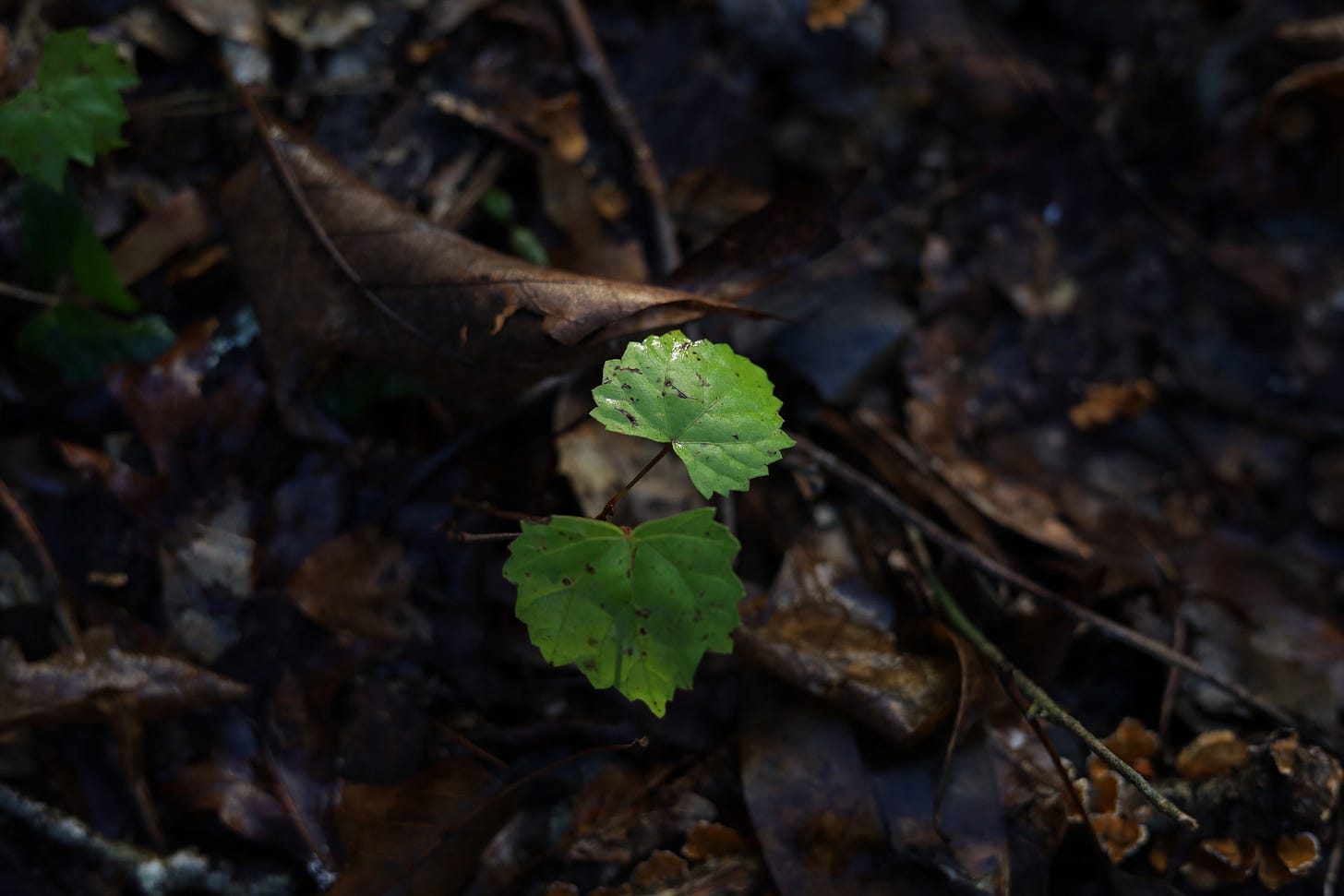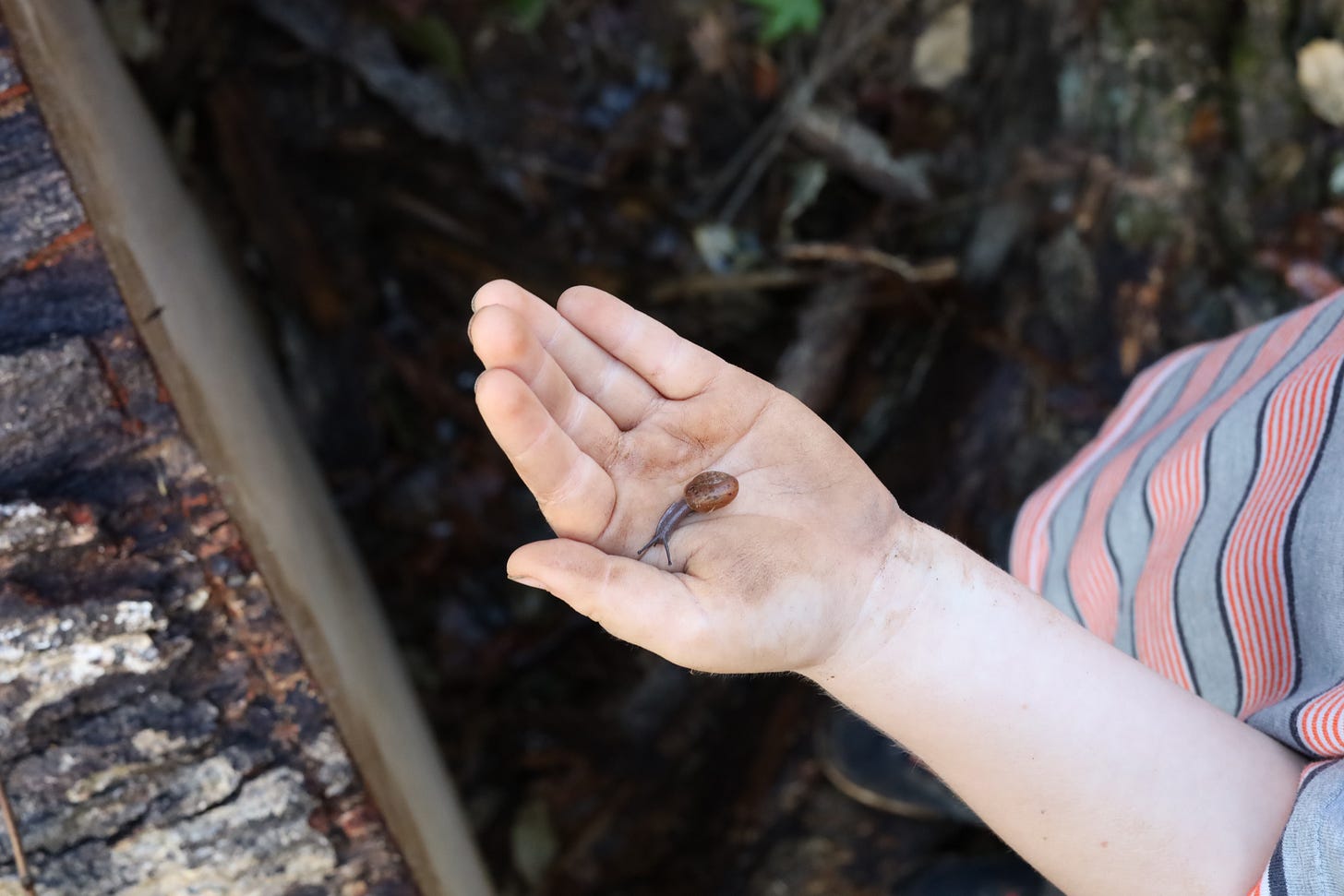There’s a new gaping hole in the tree canopy of our backyard. In the end of September, Hurricane Helene whipped through our yard and took down many beloved trees.
The tall oaks and colorful maples are what first caught our eye when we were house hunting six years ago. Higher on my checklist than an updated kitchen was trees. Lots of them. I can’t conjure up a mature tree the way I can add a coat of paint, slap up a backsplash, or plant some hydrangeas to spruce up a place. The loss of so many trees has been heavy on our hearts as we also process the even greater devastation experienced in Western North Carolina.
A few days after the hurricane, a question arose in my spirit as I walked between broken branches and sideways trees: what can now grow? I keep turning that question over in my soul, tenderly holding it with hope. You see, we’ve had a transition in our lives this summer- a shift of responsibilities, commitments, and community. It’s been one that, while chosen by us, has been bittersweet. Good decisions are still hard to make when they come at a cost.
This shift has left me with a gaping hole. Not a wound, but rather an opening. A space where more light is filtering in and the soil has been churned a bit. What remains? What needs tending? What can now grow?
________________
A few weeks ago, a skid steer, excavator, commercial chipper, and four large men with chainsaws hacked through our yard moving debris for two days. My four-year-old son glued himself to the rocking chair on our sunporch to watch every minute of it (very expensive babysitting if you ask me). My 21-month-old learned a new skill: walking over to the window with her hand spread over her surprised, o-shaped mouth as she exclaimed, “Oh gosh! Oh gosh! Twee fall!” Apparently, I had done that only a few (okay maybe many) times during that whole escapade.
After the first day, the constant sound of chainsaws left me quite irritable by the time dinner rolled around. I wanted to end the day and get the kids in bed for some peace and quiet, but I’d committed to a ladies night just down the street from me. I didn’t know most of the women attending, barely even the host, but I’d initially been excited to meet neighbors and other women in our area. However, the last thing I wanted at that moment was meet new people. Pajamas and a good cry over a bowl of ice cream sounded like a better alternative. Instead, I put on my big-girl pants (aka my maroon skinny jeans), dangly earrings, and a little lip gloss.
With our van safely parked in our neighbor’s driveway during the upheaval of our yard, I had to trudge across her yard to reach it. While doing so, I decided to heed my husband’s wise advice to decompress for a few minutes before getting into the van. I turned around to gaze at our house from a different viewpoint. The soft orange and pinks of the sunset unrolled right above the opening in our backyard and that question floated to mind again: What can now grow? In the quiet sliver between day and night, I paused, taking in the beautiful juxtaposition of the golden sunset and damaged trees.
The night turned out lovely, of course. Everything I hoped for and more. (Please remind me of this the next time I put myself out there because inevitably, I will still worry.)
_____________
There’s an educational sign tucked in the back of Hatcher Garden, our local woodland and botanical garden. With a circle of eight pictures and arrows, they depict the cycle of a forest succession with a title in the middle: Nature Is All About Change. I skim the sign every time I’m there while my kids play on the fallen oak behind it pretending to be gymnasts crossing a balance beam.
The first sentence explaining this natural phenomenon reads: “When a storm or fire destroys a forest, the area will suddenly be open to more sunshine. This permits seeds buried in the ground, sometimes for years, to sprout.” I always imagine the miracle of a tiny, fragile seed laying dormant for years before the conditions are right for it to grow.
At the prospect of new growth in our backyard, I’ve begun to think about new growth in my own life, contemplating ideas or desires sitting in the soil of my heart. An equally tender, yet much less hopeful question has also been hanging around: What if this doesn’t work?
What if we take a leap and fall flat? What if I put myself out there and I’m rejected? What if I think I’m following God, but find a dead end? What I plant and grow, but a storm comes later and knocks things over?
I have planted enough bushes and seeds and flowers in our yard to know that sometimes they don’t make it. Or sometimes they grow, but never flower. Or they are choked out by weeds and invasive vines. Or they wither during the winter never to return the following spring leaving me with more questions than answers.
This line of thinking usually leads me to paralysis. Maybe it’s just better to hunker down and wait for the neon sign or email from God to take the next step. Feeling fragile and fearful, I choose not to do anything.
Sometimes, rest and quiet is what’s needed for a period of time as we learn to accept where we are for a season of life and surrender our own agendas. I don’t want to discount the necessity of winter and the rest of our souls. From this quiet place, seeds can germinate naturally without much effort on our part, but at other times, we might need to pick up the shovel.
There’s another line on the forest succession cycle sign that states, “When we have a damaging wind, we may take down broken trees for safety reasons and take it upon ourselves to replant newly opened areas rather than wait 150 years for it to happen naturally.”
In other words, sometimes, we need to plant.
______________
If you ever come to my house, you’ll be greeted by a very colorful flower bed to the right of our driveway right as you pull in. Once upon a time, it had a big, dying oak tree in the middle of it. I tried to plant several ferns and hostas in it’s shade, but the ferns never survived and the hostas were eaten by deer. This flower bed became a sore spot for me.
After the tree was taken down, I promptly drove to our local nursery with renewed hope as I selected an array of bright, sun-loving plants. It is now my favorite flower bed.
The fringe flower bushes remain purple year round and dazzle us with a blaze of red flowers in the spring. Tucked between those are hydrangeas with showy, white blooms. Three ‘encore’ azaleas in are bloom as I type this- their second performance of the season. Several distylium reach their wild branches out, a steady evergreen anchoring the back of the bed. A few abelian bushes, with the lovely name ‘kaleidoscope’ due to their lime green leaves and bright red stems, contrast the purple heart nearby. This year, I planted zinnias too, which is where my new friend, the Gulf Fritillary, greets me each afternoon as I wait for my daughter to get off the bus.
While some seeds and plants may die, many thrive. As much as I would like to forecast which will succeed or wither, I’m only human. I cannot see into the future. I don’t know everything about gardening. Or life.
And what is success anyways? Every mistake, misstep, or dead end has still taught me an invaluable lessons. Every withered plant becomes nourishment for the soil as it decomposes. God can redeem all things and moves mysteriously in our lives. The work of faith is trusting God as we push out the shovel blade into the soil.
I love how the writer of Ecclesiastes, ever the melancholy, glass-half-empty, yet merry, eat-drink-and-be-happy mentor, speaks to these questions:
“Whoever watches the wind will not plant;
whoever looks at the clouds will not reap.
As you do not know the path of the wind,
or how the body is formed in a mother’s womb,
so you cannot understand the work of God,
the Maker of all things.
Sow your seed in the morning
and at the evening let your
hands not be idle
for you do not know which will succeed,
whether this or that,
or whether both will do equally well.”
(Ecclesiastes 11:4-7)Risk is part of the adventure, part of the living. Risk is having babies and growing gardens. Risk is meeting new people and treasuring old friends. Risk is choosing to rest and opening the seed packet. Risk is putting words on paper or paint on a canvas. Risk is showing up even though we’d rather hang home in our pajamas. Risk is counting the cost, but following God anyway. Risk is understanding the loss, but keeping your eyes on the gain.
________________
There’s another intriguing sign at Hatcher Garden. It stands in front of a different tree stump and reads: “Dead… or Alive? … A fallen tree is one of the richest habitats in the forest for plants and animals. There are many living things on and around this tree… some crawl; some fly; some don’t move an inch.”
The crucifixion of a man named Jesus over 2,000 year ago set the world ablaze with this same question that has carried on through the centuries: “Dead… or alive?”
As with the stump in the garden, we might have to get on our knees and look closely.
What was once a dark, cold tomb holding his body, is now an empty grave, a gaping hole ushering in the tender warmth of God’s Spirit. Jesus counted the cost and took the risk anyway. Hebrews 12:2 puts it this way: “For the joy set before him he endured the cross, scorning it’s shame and sat down at the right hand of the throne of God.” In a cosmic forest succession, he laid down his life, so we could begin ours. His joy becomes our merciful nourishment as we crawl, fly, rest, plant, risk, dream, and grow.
____________
What can now grow where the grand oaks once stood, as guardians of our land? Rooted and sturdy, a home for the wild, they now lie tangled and torn. What great awakening, what seed can emerge now kissed by the warmth of the sun? For a shift in the ground released secrets long buried of dreams, of hopes, of story. What saplings stooped low beneath broad crowns are now free to explore and roam? Once shaded from orbs, and sheltered from wind, they now shimmer in the light of the moon. I pause in the glow of the sinking sun as glory spills into this space. Between moss and ferns my spirit here yearns for a place to plant firm and call home. The wind lifts my hair my heart now aware of the mirror this landscape bestows. For what, oh my soul, can now grow?
This post is part of a blog hop with Exhale—an online community of women pursuing creativity alongside motherhood, led by the writing team behind Coffee + Crumbs. Click here to view the next post in the series "Tender."














Kim, this post is a feast with beautiful offerings of both your words and dripping in delicious gospel truth, with even a poem at the end— I truly enjoyed each nuanced new segment, especially the one on “risk.”
Love the poem and photos!